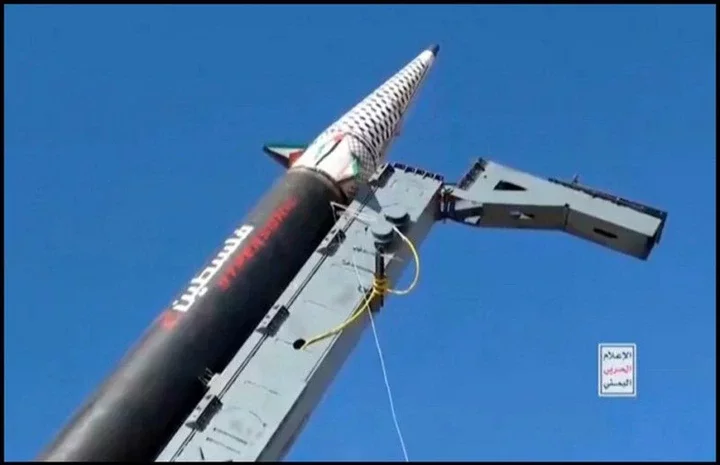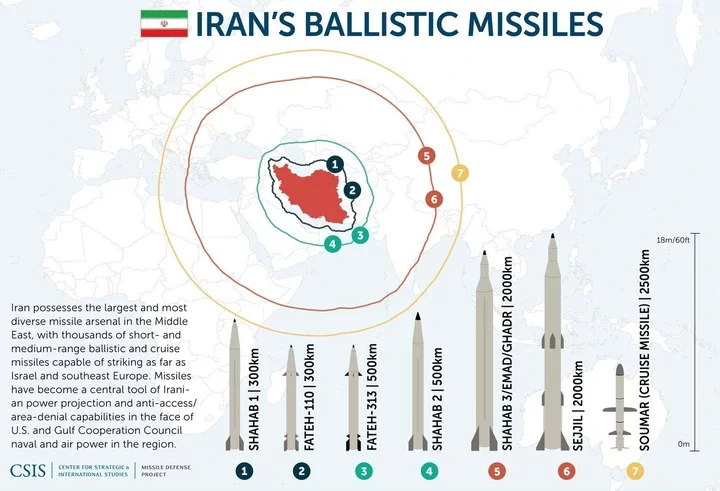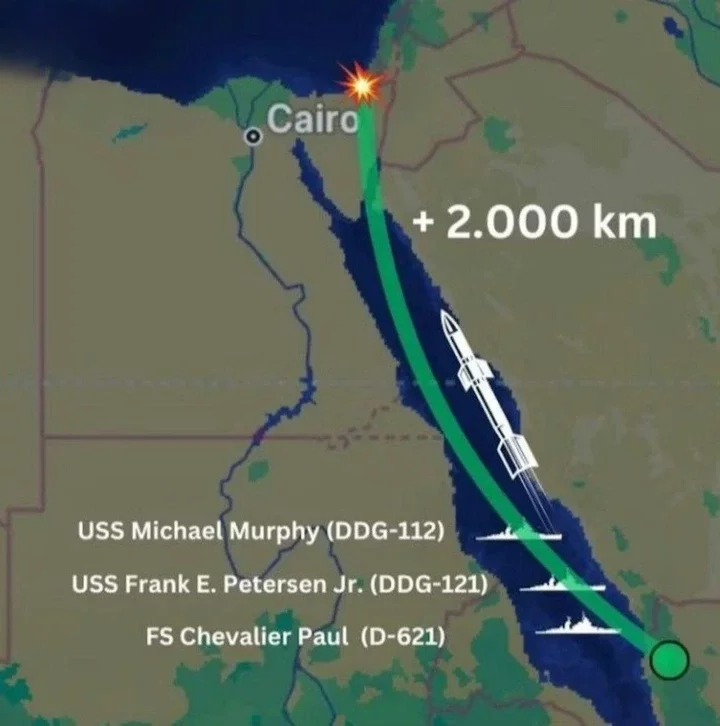
The Attack
On September 15, 2024, the Houthis successfully struck at Tel Aviv with an IRBM fired from Yemen. Israeli claims that the missile was intercepted cannot be confirmed. The attack was shrouded in the fog of war. There were reports that the missile struck near Tel Aviv airport.
Later reports claimed that Iron Dome missiles proved ineffective against the missile. This is not unexpected because the Iron Dome is a short-range air defense system that is most useful against slow, unguided artillery rockets and subsonic cruise missiles. The question is whether Arrow 3 and Patriot air defense missiles were engaged. If so, they also missed.
The Houthis claimed that they had fired a "hypersonic ballistic missile" and published a video purporting to be of the missile's launch. A picture of the missile from that video is displayed in Figure 1 at the top of this article. The video published by the Houthis is available here: Houthi video of missile launch.
The claim that the missile was "hypersonic" is disingenuous. In practice, almost all ballistic missiles are hypersonic in their terminal phase. Even the German V2 from World War II reached Mach 5 in its terminal phase and gave no warning before impact.
In fact, there is reason to believe that the video published by the Houthis was not a video of the actual missile fired. Some analysts thought the missile was a variant of the Iranian Fatah-110 missile. This writer finds that improbable. It might be a video of a Fatah-110, but that missile has a range of only 400km and a speed of Mach 4. It could not have done the job. The strike was a success. Why publish a misleading video?
The missile in question was far beyond the indigenous ability of the Houthis to develop. It was probably a variant of a more advanced Iranian missile - a Shahab 3, Emab 1, or Seijil (Ashura). Variants of these three all have ranges of up to 2,000km and can reach Tel Aviv. The Shahab and Emab are liquid-fuelled. The Seijil (Ashura) is solid-fuelled. All three are road-mobile.
Figure 2 shows the ranges of ballistic missiles in the Iranian arsenal. Notice that the longer-range missiles that could have done the job do not have the nose fins of the Fatah-110 shown in the published video.

The bottom line is that we don't know what the missile was. There is another possibility. If it was not one of the three from Iran with sufficient range, it might have been provided by a sophisticated actor from outside the region.
This article is concerned with another mystery.
The Houthi missile traveled from Yemen up the Red Sea and impacted Tel Aviv. On its way, it overflew a French frigate (the FS Chevalier Paul), and two US Arleigh Burke destroyers (the USS Michael Murphy and the USS Frank E. Petersen Jr.). The French ship is not a concern, because it is not anti-ballistic missile (ABM) capable. Both Arleigh Burkes are equipped with Aegis AN/SPY-1 radar and ABM defenses (RIM-161 Standard 3 missiles.) Presumably, there were more Aegis destroyers in the Med.
Why did the Aegis destroyers not fire on the Houthi missile?
The Silence was Deafening
The flight path of the Houthi IRBM took it 2,000km up the Red Sea from Yemen to Tel Aviv. Figure 3 shows how it overflew three coalition warships. A French air defense frigate and two ABM-capable Arleigh Burke-class Aegis destroyers.

Figure 3 shows the frigate and destroyers in the Red Sea. There were other Aegis destroyers in the Eastern Mediterranean.
This was not the first time Aegis destroyers were in a position to engage ballistic missile threats in a combat situation. On April 13, 2024 Iran launched a massive drone and missile attack against Israel. In a previous article, Electronic Warfare 101 - Iran's Strategy Against Israel I described that attack and how it lit up Israel's and the coalition's entire air defense radar network. This was a retaliation against the Israeli attack on the Iranian embassy in Damascus. The nature of the retaliation was the result of intense diplomacy between the US and Iran via intermediaries. The diplomatic objective was to calibrate the Iranian retaliatory attack to warn the Israelis of Iran's capability, but minimize the risk of escalation. The Iranians conceded the US and Israelis 48 hours notice of the attack, and launched slow-moving drones before the IRBMs. The drones took five hours to reach their targets, providing the coalition even more warning.
Mass media trumpeted the Israelis' success in shooting down "99%" of the attackers. Mass media, the Israelis, and coalition spokesmen also denigrated Iran's capability. In fact, they shot down 100% of the drones that were meant to be shot down. It remains unclear how many, if any IRBMs were shot down. The IRBMs constituted a much smaller proportion of the strike. Modern IRBMs hit their targets. Other IRBMs (obsolete types sacrificed by the Iranians) broke up in flight because they tumbled during re-entry. Those were not shot down.
Professor Theodore Postol, Professor of Science, Technology and National Security at MIT, estimates the actual hit probability of Israel's Iron Dome to be less than 0.05 or 5 hits for every 100 interceptors fired. In this video Ted Postol - Iron Dome System) he analyzes video of the attack and shows modern Iranian IRBMs striking their targets, and older IRBMs breaking up. Crucially, he points out that there is no evidence of attempts to intercept the missiles. Postol also describes the Israeli air defense system - Iron Dome, David's Sling, Arrow 2 and Arrow 3.
As a result of the attack, and the Israeli response, Iranian and Russian electronic warfare assets managed to map Israel and the coalition's entire air defense network in one night.
The attack of April 13 consisted of a large number of drones and a smaller number of ballistic missiles. The attackers were engaged by Israeli air defense, as well as US and UK fighters armed with long-range air-to-air missiles. Again, there were Aegis destroyers in the area, but we do not know if they were used to engage the incoming IRBMs. They should have been, but we just don't know.
In any event, the later September 15 attack was the first combat situation in which Aegis destroyers unambiguously had an opportunity to engage an IRBM threat in a combat situation. The two destroyers presence in the Red Sea was noted in reports for the 24 hours following the attack, then faded from subsequent accounts.
Let's explore the possibilities.
Possibility #1: The Aegis Radar Was Jammed
Russia has been supplying Iran with sophisticated electronic warfare assets, including Murmansk-BN long range jammers (range 3000 to 5000km), and possibly Krasukha 2 and 4, which are known to be deployed in Syria.
Future articles will discuss these aspects of electronic warfare in more detail. Suffice to say that there are two ways to render an assault vehicle "stealthy". One is structural - by designing the shape of the platform to be radar-resistant (e.g. the distinctive airframes of the F-117, B-2, B-21 and F-35, the use of radar-absorbent materials and so on). The other is digital - by using counter-electronic warfare.
One way to render an attacking vehicle stealthy is to jam enemy radar. Radar works by sending out electromagnetic pulses. When those pulses strike an object like an airplane, they bounce back and the radar station can determine altitude, bearing, and velocity. The radar stations, which would have been mapped by the Iranians and Russians the night of April 13th, operate from certain locations, in certain modes and frequencies. They put out electromagnetic energy in an organized manner to detect and track targets.
To jam those radars, an attacker might throw tons of electromagnetic energy into the ether. A huge amount, poured in the direction of enemy radars, at the frequencies and wavelengths they use. They just fill the ether with so much electromagnetic radiation that the radars can no longer distinguish an attacking vehicle's signature from the surrounding noise.
Radar stations counter this jamming by frequency-hopping. That is, if they find themselves jammed at one frequency, they hop to another, and another and another. Previously, on April 13, the Iranian and Russian data collection effort would have mapped the frequency-hopping behavior of Israeli and coalition radars. Even if the hopping was randomized, they would have mapped the necessarily bounded ranges over which the hopping occurred. All this from ground stations, ships, fighters, and AWACs.
If your radar transmits on one frequency, the enemy can flood that frequency with noise. If you hop to another frequency, the enemy hops with you. Sweep-jamming requires the jammer to transmit noise over a sequence of frequencies. Barrage-jamming requires the enemy jammer to flood the whole range. If the enemy floods the S and X bands with garbage, you are blind. You know he's out there. But if he jams your comms, you can't report in.
There are two difficulties with jamming. First, it consumes a tremendous amount of power to fill the ether with confusing electromagnetic radiation. Especially if it is operating at a distance across a wide range of frequencies. Second, if the enemy finds themselves being jammed, they know there is an attacker out there and will step up efforts to find and track it.
It is possible that the Houthis and Iranians, jammed the AN/SPY-1 radars of the Aegis destroyers in the Red Sea. That would have rendered the destroyers incapable of engaging the missile, but would have alerted the defenders in Israel and the Mediterranean.
Possibility #2: Standard 3 Missiles Were Fired and Missed
It is well known that the theoretical hit probability of an air defense missile is less than 1.0. In most cases, theoretical hit probability is more like 0.8, but this is really a guess. Only after many, many tests or combat engagements can an actual, or empirical hit probability be determined. For this reason, it is standard procedure to fire at least two, and often three interceptor missiles for each incoming threat.
Professor Postol and his colleague, George Lewis, conducted extensive analysis of the Standard 3 air defense missile and concluded that its effectiveness in shooting down ballistic missile threats was questionable. This paper is a detailed technical analysis of potential flaws in the Standard 3 system: Lewis & Postol: Technical Analysis of Flaws in Standard 3. While necessarily technical, it is highly recommended to anyone who seeks to understand ABM defense.
The DOD rebutted the work of Postol and others by claiming their work was based on early test data and the Standard 3 missile had evolved to become more reliable. There the matter has lain, but the effectiveness of Aegis and Standard 3 against BMs in actual combat has never been satisfactorily demonstrated.
Absent a detailed account of the Aegis destroyers' performance on the night of September 15, we don't know if Standard 3 missiles were fired at the IRBM and missed.
In this video, Postol discusses Iran's April 13 attack, the performance of Patriot during the First Gulf War in 1991 (he found no evidence that Patriot succeeded), and the pattern-recognition technology used by Iranian missiles to strike a Saudi Arabian oil refinery. Postol - The Truth Behind Iran's Missile Attack on Israel.
Conclusion: The Threat Level is Rising
What we take away from the night of September 15 are two difficult questions:
First, what missile did the Houthis use to attack Tel Aviv, and where did it come from? We know it was not the missile in the video they published. The missile they used was far more capable. We do not know if it was supplied by the Iranians or by some extra-regional actor.
Second, we do not know how that missile managed to overfly two Arleigh Burke-class destroyers specifically equipped for anti-ballistic missile defense.
Tension in the area is high, with a high probability of escalation. Sophisticated drone and missile attacks from the Houthis, Iran, and Hezbollah can be expected. We need the most effective air and missile defense available.
















Comments